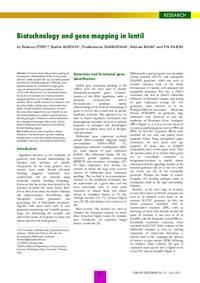Biotechnology and gene mapping in lentil

Authors:
Genomic tools and genetic mapping are assisting the understanding of the lentil genome and have made possible the use of marker assisted selection for breeding purposes. Although some important traits are conferred by single genes most are determined by quantitative trait loci (QTL) and influenced by environmental factors. Genes for several traits have been genetically mapped and shown to be linked to molecular markers. These include resistance to fusarium wilt, ascochyta blight, anthracnose, and stemphylium blight. Winter hardiness and tolerance to frost have also been mapped. It is now feasible to use the linked markers in a marker assisted selection breeding program. Proteomics and metabolomics are emerging technologies that can be used to better characterize the functional mechanisms behind breeding targets.
